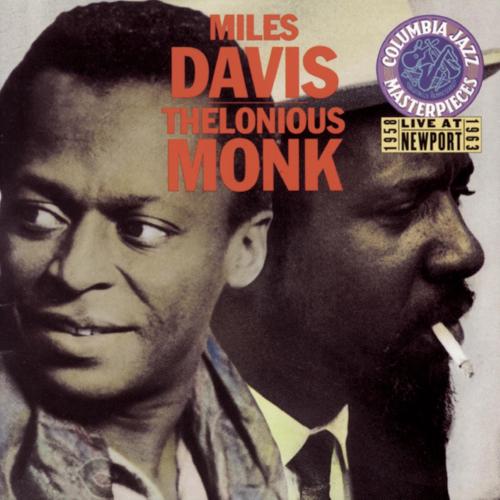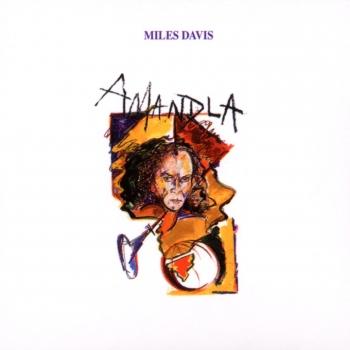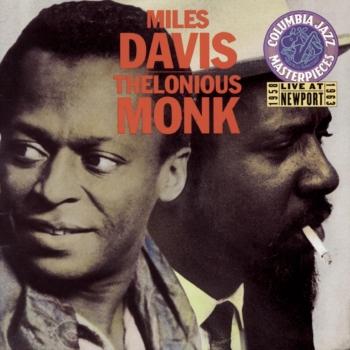
Miles and Monk at Newport Live (Remastered) Miles Davis
Album info
Album-Release:
1964
HRA-Release:
03.02.2017
Album including Album cover
I`m sorry!
Dear HIGHRESAUDIO Visitor,
due to territorial constraints and also different releases dates in each country you currently can`t purchase this album. We are updating our release dates twice a week. So, please feel free to check from time-to-time, if the album is available for your country.
We suggest, that you bookmark the album and use our Short List function.
Thank you for your understanding and patience.
Yours sincerely, HIGHRESAUDIO
- 1 Ah-Leu-Cha 05:47
- 2 Straight, No Chaser 08:46
- 3 Fran-Dance 07:04
- 4 Two Bass Hit 04:13
- 5 Nutty 13:55
- 6 Blue Monk 11:15
Info for Miles and Monk at Newport Live (Remastered)
Miles & Monk at Newport was a combined album of a Miles Davis appearance at Newport with an appearance of Thelonious Monk, from the LP era. Despite the title, the two artists do not perform together on the recordings, and they are represented on each side by separate live appearances at the Newport Jazz Festival.
„At the time of this album's original release (as Miles & Monk at Newport), Thelonious Monk was really hitting his stride as a jazz star and was then, like Miles Davis, signed to Columbia. Critics usually damn Monk's '60s groups with faint praise, but listen to the fiery interplay Davis and Monk bring to his splintery rhythmic displacements on "Criss-Cross," and their dancing joy on "Epistrophy." "Light Blue" is one of Monk's harmonically free-ranging little blues, taken at such an expressively slow tempo, his chords take on a symphonic breadth behind Charlie Rouse's endless lyric elisions. But the main attraction of this concert was the cross-generational accord between Monk and clarinetist Pee Wee Russell, who sits in on Monk's famous blues "Nutty" and "Blue Monk." Closer to the Dixieland school than bop, Russell nevertheless responds brilliantly to Monk's urgent abstract Charleston on "Nutty," and when the pianist drops out to let him stroll, he responds with a wink and some knowing dissonances. "Blue Monk" is even better, as Russell's wistful, teardrop timbre inspires insistent counterpoint from Monk, and his tonal abstractions lead perfectly into Monk's solo -- proving that styles don't clash, only people. Miles' 1958 set begins with a brisk, aggressive romp, as the sextet charge through Bird's contrapuntal line "Ah-Leu-Cha," then settle into a deep, deep groove on their famous arrangement of Monk's "Straight, No Chaser." Listen to the way Bill Evans, Paul Chambers, and Jimmy Cobb deconstruct the time and harmony behind Miles' spacious intervals, only to lock up and fly in the second chorus. John Coltrane really whips it up here (and on a blazing "Two Bass Hit"), his ideas crowded together like blood corpuscles lining up to pass through a single capillary. Inspired by Coltrane's complexity (and Cobb's power), Cannonball Adderley responds with a contrasting gospel blues feel, while Evans offers a coy, bluesy transition to Chambers' resounding dance.“ (AMG)
Davis in 1958:
Miles Davis, trumpet
Cannonball Adderley, alto saxophone
John Coltrane, tenor saxophone
Bill Evans, piano
Paul Chambers, bass
Jimmy Cobb, drums
Monk in 1963:
Pee Wee Russell, clarinet
Charlie Rouse, tenor saxophone
Thelonious Monk, piano
Butch Warren, bass
Frankie Dunlop, drums
Recorded May & July 1958 (Miles Davis Sextet), April 1963 (Thelonious Monk Quartet)
Produced by Teo Macero
Digitally remastered
Trumpeter Miles Davis grew up in East St. Louis, Illinois, just across the river from St. Louis, Missouri. His parents were affluent, and had the means to support his musical studies as a boy. He began playing the cornet at age nine, and received his first trumpet at around twelve or thirteen. He studied classical technique, and focused mainly on using a rich, clear tone, something that helped define his sound in later years.
As a teenager, he played in various bands in St. Louis, which was rich with jazz, as big bands often stopped there on tours throughout the Midwest and southern states. The most important experience he had was when he was asked to play in the Billy Eckstine band for a week as a substitute. The group included Charlie Parker, Dizzy Gillespie, and Sara Vaughan. After playing with these stars, Davis knew he had to move to New York to be at the heart of the jazz scene.
In Pursuit of Parker:
In 1944 Davis moved to New York City where he had earned a scholarship to study trumpet at the Juilliard School of Music. Upon arriving however, he sought after Charlie Parker, and meanwhile spent all of his time in jazz clubs listening to bebop. He was transfixed on the music, and grew utterly bored with his classical studies. After less than a year at Juilliard, he dropped out and tried his hand at performing jazz.
Although not particularly stunning, his playing was good enough to finally attract Charlie Parker, and Davis joined his quintet in 1945. He was often criticized for sounding inexperienced, and was compared unfavorably to Dizzy Gillespie and Fats Navarro, who were the leading trumpeters at the time. Both boasted stellar technique and range, neither of which Davis possessed. In spite of this, he made a lasting impression on those who heard him, and his career was soon set aloft.
Cool Jazz and a Rise to Fame:
Encouraged by composer and arranger Gil Evans, Davis formed a group in 1949 that consisted of nine musicians, including Lee Konitz and Gerry Mulligan. The group was larger than most bebop ensembles, and featured more detailed arrangements. The music was characterized by a more subdued mood than earlier styles, and came to be known as cool jazz. In 1949 Davis released the album Birth of the Cool (Captiol Records).
Change of artistic direction became central to Davis’ long and increasingly influential career. After dabbling in hard bop as a leader on four Prestige recordings featuring John Coltrane, he signed with Columbia records and made albums that featured Gil Evans’ arrangements for 19-piece orchestra. These were Miles Ahead, Porgy and Bess, Sketches of Spain, and Quiet Nights. He rose in popularity with these recordings, in part due to his signature sound, which he often enhanced by using a Harmon mute.
Kind of Blue and Beyond:
In 1959 Davis made his pivotal recording, Kind of Blue. It was a departure from all of his previous projects, abandoning complicated melodies for tunes that were sometimes only composed of two chords. This style became known as modal jazz, and it allows the soloist expressive freedom since he does not have to negotiate complex harmonies. Kind of Blue also featured John Coltrane, Cannonball Adderley, and Bill Evans. The album is one of the most influential in jazz, and is Columbia Records’ best-selling jazz record of all time.
In the mid 1960s Davis changed directions again, forming a group with Herbie Hancock, Wayne Shorter, Tony Williams, and Ron Carter. This group was known for the excellence of each individual member, and also for its unique performance approach. Each night the tunes would sound different, as the musicians would sometimes only loosely adhere to the song structures, and often transition from one right into the next. Each player was given the chance to develop his solos extensively. Like all of Davis’ previous groups, this quintet was highly influential.
Late Career:
Despite health problems, drug addiction, and strained personal relationships, Davis continued to play, changing his approach with each new project. In the late 60s and 70s, he began to experiment with electronic instruments, and grooves that were tinged with rock and funk music. Two famous recordings from this period are In a Silent Way and Bitches Brew. By the time the 1980s rolled around, Davis was not only a jazz legacy, but a pop icon, whose music, persona, and fashion style were legendary.
Davis died in 1991, as perhaps the most influential jazz artist ever. His vast body of work continues to be a source of inspiration for today’s musicians. (Jacob Teichroew, About.com Guide)
This album contains no booklet.



































